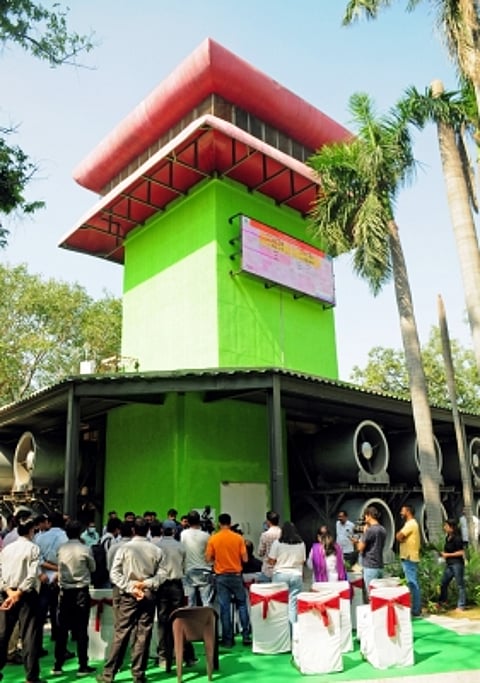Delhi Govt had installed two smog towers after a Supreme Court ruling in August 2021. (IANS)
How effective is smog tower as AQI deteriorates in Delhi?
By Avinash Prabhakar
To check air pollution in the national capital, the Aam Adami Party (AAP) government in Delhi had installed two smog towers after a Supreme Court ruling in August 2021. However, the much-hyped move has not yielded the desired result as the city's air pollution continues to fluctuate from 'very poor' to 'severe' category during the winter.
The Delhi government had on many occasions claimed that the smog tower installed at Cannaught Place has a 'noticeable impact' on reducing air pollution within a 300-metre radius.
However, on visiting the site at Cannaught Place, the tower was not found in running condition. On being asked about its status, the staff present at the site said that it has been stopped temporally just one hour back, as the humidity in the atmosphere has risen beyond a certain level.
"When the system indicates moisture, or humidity goes beyond 70 per cent, we stop the facility," one staff said.
"All the regulations and running criteria are being passed by a research team, which instructs us as per the deviation in the weather," he added.
However, environmental experts have different opinions on the effectiveness of smog towers, and they mostly dismiss the reports citing faults in the methodology.
On condition of anonymity, a senior scientist at a government facility told IANS that it is simple to understand that if the smog tower observes pollutants in that limited area, as being claimed, it also desecrates the same in Delhi's air.
"So, how it is going to help in curbing pollution," he asked.
"There is no scientific research or basis behind the functioning of smog towers. Whatever studies have been conducted so far on the effectiveness claim of smog tower have showed that they are not helping in curbing air pollution," Chandra Bhushan, CEO of iFOREST, an independent non-profit environmental research and innovation organisation, told IANS.
More than a technology to reduce pollution, Bhushan said, smog tower has become an object for the government to show that it is working to fight pollution.
"Such technology is not feasible in Delhi on two grounds - first, there is no scientific evidence, and the second is high cost. If Delhi government really wants to fight pollution, it should provide subsidised LPG to those living on the outskirts of the city who use wood and coal for cooking. Also, the government must invest in public transport so that pollution in the city can be reduced," Bhushan said. (SJ/IANS)


